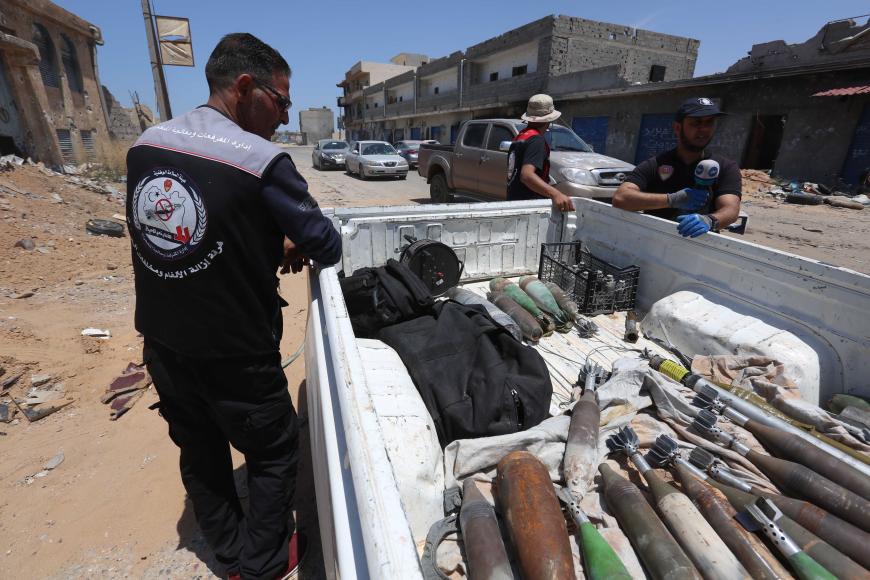29/04/2022 Libia, Tripolitania, Tripoli
“If you ever come across anything suspicious like this item, please do not pick it up, contact your local law enforcement agency for assistance”
At least 130 people, mostly civilians, have been killed by landmines and abandoned or unexploded ordnance in Libya since the armed group called the Libyan Arab Armed Forces (LAAF) withdrew from Tripoli’s southern suburbs in June 2020, Human Rights watch said today. Fighters affiliated with the group, commanded by Khalifa Hiftar, and foreign fighters from Russia emplaced banned antipersonnel mines, including victim-activated improvised explosive devices (IEDs) and booby traps in Tripoli’s southern suburbs, as they withdrew. The Libyan government and its international supporters should intensify efforts to clear landmines and unexploded ordnance around Tripoli, the capital. Forces allied with Khalifa Hiftar laid landmines and improvised explosive devices that have killed and maimed several hundred civilians including children and hinder southern Tripoli residents from returning home,” said Hanan Salah, Libya director at Human Rights Watch. “Antipersonnel mines are banned because they indiscriminately kill civilians both during fighting and long after the conflict ends.” From April 2019 to June 2020, fighters under Hiftar and affiliated forces, including the Wagner Group, a Russian government-linked private military security contractor, fought against armed groups of the former Tripoli-based Government of National Accord (GNA), which was also supported by foreign fighters. The fighting left behind enormous amounts of explosive remnants of war, including unexploded and abandoned ordnance in all of Tripoli’s southern districts. During a March 2022 visit to Tripoli, Human Rights Watch met with the Defense Ministry’s Libyan Mine Action Center, which coordinates humanitarian mine action efforts, Libyan and international civic groups working on mine action, United Nations officials, and demining specialists from the Ministry of Interior Criminal Investigations Department. Researchers also talked with officials from the Ain Zara district and El-Fernaj, among the conflict’s hardest-hit areas. Since 2019, landmines and other explosive ordnance have contaminated 720 million square meters in the southern Tripoli districts, which have caused injuries, deaths, and displacement of thousands of Tripoli residents, the mine action center said. In addition to the deaths, about 200 people have been injured. Officials from the government, the UN, and civic groups said that impediments to clearing contaminated areas included fragmented governance and insufficient coordination among government agencies and humanitarian groups. Efforts have also been hindered by the lack of a centralized data-gathering system, inadequate capacities among some deminers, and funding shortfalls for equipment and training. Human Rights Watch also interviewed civilians displaced by the fighting in Ain Zara, Salaheddin, and Gasr Bin Ghashir districts, who were unable to return home due to the risk of landmines and other explosive ordnance. On April 20, Human Rights Watch wrote to the Government of National Unity (GNU) and to the LAAF with its research findings. They have not replied. Landmines and explosive remnants of war result not only in direct loss of life and property, but they also cause so-called reverberating harm that undermines basic human rights. This includes displacement, a reduced standard of living, and impaired access to shelter, health care, education, and basic services such as electricity. Survivors often require long-term medical assistance and specialized treatment. The Human Rights Watch review of photographs, videos, and information provided by humanitarian mine groups identified 10 antipersonnel mines of Soviet and Russian origin and a number of victim-activated improvised explosive devices that were used in the Tripoli conflict. Four antipersonnel mines of Russian origin had not been previously documented in Libya. The explosive devices of an improvised nature were assembled and used in a manner intended to be detonated by the presence, proximity, or contact of a person, and could injure or kill multiple people, Human Rights Watch said. The 1997 Mine Ban Treaty prohibits such victim-activated devices, including those made locally. After Human Rights Watch documented landmine use by forces of the late Libyan leader Muammar Gaddafi in 2011, Hiftar and other armed group commanders pledged to never use landmines and to provide mine clearance, victim assistance, and education about mine dangers. Yet Human Rights Watch has continued to uncover new use of prohibited landmines. Libya is not among the 164 countries that have joined the Mine Ban Treaty, which prohibits antipersonnel landmines and requires their clearance and victim assistance. The only other African nations not treaty members are Egypt and Morocco. In November 2020 Libya’s former Government of National Accord told Mine Ban Treaty countries that it had established a working group to prepare for Libya’s accession to the treaty. On March 28, Prime Minister Abdelhamid Dabeiba in the current Government of National Unity addressed the need for more support to clear explosive remnants but did not say when Libya would join the treaty.
If you find anything that appears to be an explosive device, do not touch it, leave it where it is and call the police. We will contact the appropriate agencies to properly dispose of the item.
Biography of a Bomb
Dear editors, Biography of a bomb is aimed at highlighting the danger caused by unexploded bombs. Moreover, the most important aspect is that we work completely non profit, raising awerness about this topic is what drives us. We apologize if we make use of pictures in yours articles, but we need them to put a context in how findings are done. We will (and we always do) cite source and author of the picture. We thank you for your comprehension.





